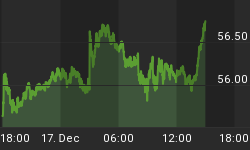Below is an extract from a commentary originally posted at www.speculative-investor.com on 2nd March, 2008.
We have two potential scenarios in mind for the gold sector, the first of which can aptly be labeled "the 1973 model" because it involves the financial markets behaving in a similar fashion to the way they behaved during 1973. To help explain this scenario we've re-produced, below, two charts originally included earlier commentaries.
The first chart compares the 1973 performances of the Dow Industrials Index and the Barrons Gold Mining Index (BGMI). The key points, here, are:
1. The BGMI was inversely correlated with the Dow during 1973 (and, by the way, for much of the 1970s).
2. The BGMI was strong from the day of the initial panic low in the broad stock market in May of 1973 (the day when the number of new lows on the NYSE exceeded 1100) until just before the Dow completed its final successful test of the panic low. The BGMI then 'corrected' for about two months while the Dow rallied.
3. When the Dow's counter-trend rebound came to an end, the BGMI's bull market resumed.

The second chart compares the US$ (the line on the chart rises when the US$ strengthens against the Swiss Franc) with the BGMI during 1972-1976. This chart shows that:
1. The start of the BGMI's downward correction in 1973 coincided with the start of the US dollar's upward correction.
2. The BGMI's 1973 downward correction ended about halfway into the US dollar's upward correction.
3. The BGMI rallied strongly during the second half of the US dollar's upward correction. That is, from October of 1973 through to January of 1974 the BGMI moved relentlessly upward in parallel with a strong US$ and a weak US stock market.

Further to the above, the 1973 model (our first scenario) entails the following sequence:
Step 1: The gold sector reaches a short-term peak in the not-too-distant future (quite likely within the next couple of weeks) at roughly the same time as the US$ commences an intermediate-term rebound and just prior to the US stock market completing a successful test of its January panic low.
Step 2: The gold sector consolidates for at least two months in parallel with strength in both the US$ and the US stock market.
Step 3: The gold sector rockets upward while the US stock market trends lower and the US$ continues to recover.
The second of the two scenarios we have in mind involves the gold sector rocketing upward over the next several weeks and reaching an intermediate-term peak during April or May.
On the assumption that one of our two potential scenarios is on the cards (there are, of course, other possibilities) it makes sense for investors/speculators with a timeframe of at least 6 months to currently have a sizeable long position in the gold sector. This is because there will either be large short-term gains leading to a good profit-taking opportunity by May, or there will be some short-term pain followed by a powerful multi-month advance leading to an even better profit-taking opportunity late this year.















